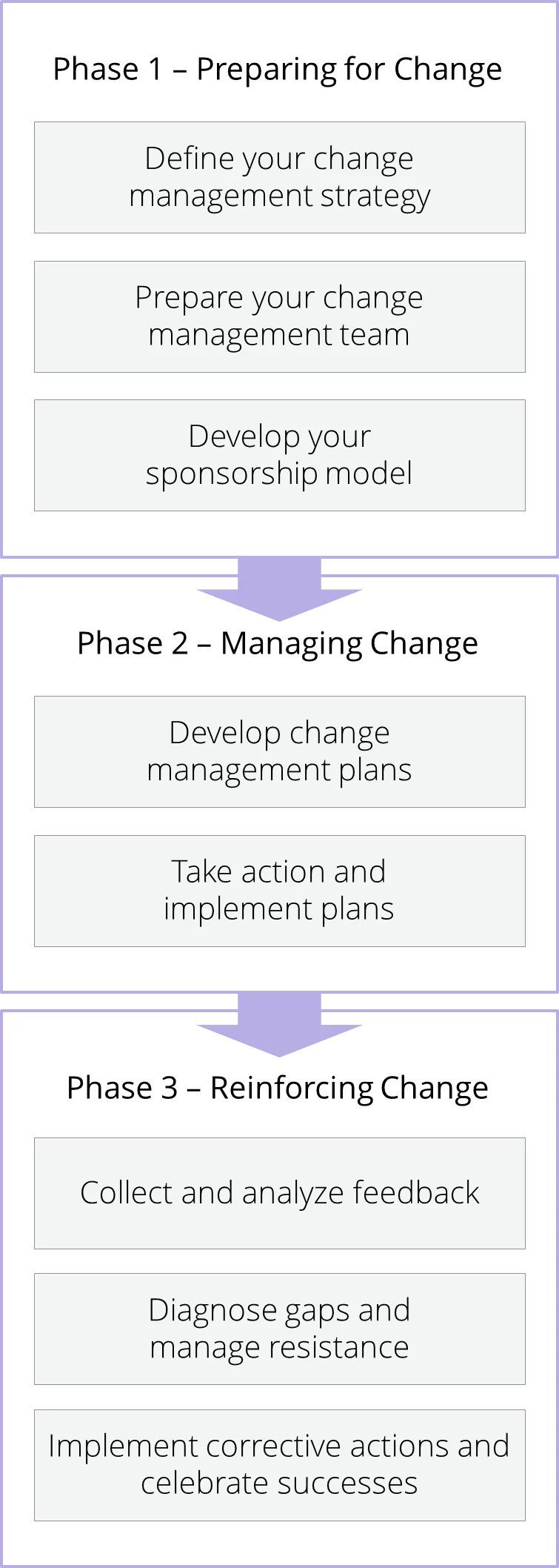
What does change management mean to you? Is it:
- An IT service management discipline. The aim is to ensure that standardized methods and procedures are used for efficient handling of changes to IT infrastructure.
- A collective term for all approaches to prepare and support individuals, teams, and organizations in making organizational change.
If you chose option 1, your change management system and approach could be out of date.
I don’t mean to say that option 1 is incorrect. But major changes to IT infrastructure should be approached as though they’re organizational changes. Not simply systemic.
Or as Mary Freeman puts it:
“To make digital transformation work…it can’t just be an IT project.”
The main difference between IT change management (1) and organizational change management (2) is its focus on people. Option 2 specifically references engaging and preparing individuals for change. Whereas option 1 makes no mention of the employees affected.
Therein lies an issue. Ultimately, all digital change revolves around people.
If you’ve ever experienced problems implementing changes, it could be because of your change management system.
ITIL change management system
As a digital change manager, you’re probably familiar with ITIL change management.
IT service and change management expert Dawid Ciechanowicz defines it as, “addressing two business needs:
- Stable delivery of defined quality IT services
- Changing IT services to better fit the business”
We’re talking about change management, so it’s the second point I’m particularly concerned with here.
The ITIL change management system is often applied to “approvals” and “authorizations”.
Approval processes can be complex. They deal with the major questions in change management; like organizational needs, costs, and benefits.
Authorization processes are more concerned with implementation. In fact, bigger companies usually limit IT’s change management capability to authorizations.
Even if this is the case, you still need to approach implementation with the approval processes in mind.
So what do you do when a need for change arises within a different department or function? Is the ITIL change management system enough to help you manage it successfully?
BMC outlines the system procedures as follows:
- Request for change review: Change coordinators use this procedure when they are dealing with requests for change.
- Change planning: Change coordinators and specialists use this process to prepare the implementation plans for changes.
- Change approval: The change manager and approvers (e.g., customer representatives and service owners) follow this procedure to approve planned changes.
- Change implementation: Specialists use this process to put in place infrastructure changes.
- Change closure: Specialists follow this procedure when they perform production tests after changes have been implemented. Change coordinators use it when they close out changes.
But this framework doesn’t address the human element of change management whatsoever. Including the risk of resistance. And this is often the cause of change management failures.
We can conclude that the ITIL change management system isn’t enough on its own. For the implementation of major digital transformation, we need a more human system.
Prosci’s 3-phase change management system
Prosci’s change management system is powerful in its people focus.

Image source: Prosci
Stage one identifies the people that are fundamental to the success of the change: the change management team.
Stage two is implementation. But stage three circles back to the people adopting the change. It specifically addresses people’s resistance to the change and celebrates their successes.
In fact, Prosci defines change management as “[understanding] what tools we have to help individuals make changes successfully.”
And there are of course many tools at your disposal. But as an IT change manager, the sort of changes you need individuals to make are digital ones.
So, an extremely effective change management software solution for you is a Digital Adoption Platform.
Using a Digital Adoption Platform (DAP)
Every stage of Prosci’s change management system can be facilitated by a Digital Adoption Platform.
The DAP term was first coined by WalkMe and then everyone started to use it.
It’s an ace up your sleeve when preparing your change management team. This is because it removes the burden of responsibility for the spread of information about new processes and procedures.
The change management team was once responsible for training individuals in new behaviors. Now the DAP handles it.
It provides on-the-spot guidance. This avoids the need for individuals to lose time on FAQ’s, instruction guides, and classroom learning.
The DAP can also collect and analyze feedback. It understands the relationship between the user and the digital platform. It makes modifications to improve the user experience and provides highly personalized guidance.
A DAP is a secret weapon when changing IT services to better fit the business. And the best thing is that it can be used within any change management system.
Use a combination of systemic change management and a human focused organizational change model. Then, with the right digital tools to support you, you’re sure to achieve your goals.
WalkMe Team
WalkMe spearheaded the Digital Adoption Platform (DAP) for associations to use the maximum capacity of their advanced resources. Utilizing man-made consciousness, AI, and context-oriented direction, WalkMe adds a powerful UI layer to raise the computerized proficiency, everything being equal.



